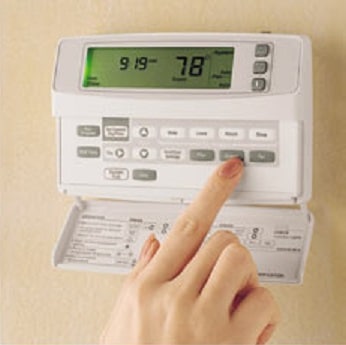 During winter we hold our breath each time the heating bill arrives. What will it be this month? Is it manageable? How can we cut it down? Thankfully, there are things we can do to help this necessary expense. Check out these 7 ideas.
During winter we hold our breath each time the heating bill arrives. What will it be this month? Is it manageable? How can we cut it down? Thankfully, there are things we can do to help this necessary expense. Check out these 7 ideas.
(1)Find yourperfecttemperature. Perhaps you could stand it a touch cooler, but just don’t know it. Experiment with both daytime and nighttime temperatures. If you’re waking up hot in the morning (or in the middle of the night), you know the thermostat is too high. Start by dropping it two degrees, then see if you can go lower. According to the American Council for an Energy-Efficient Economy, you can save about 3% for every degree you lower your temperature.
Once you know your perfect temperatures, program your thermostat. By using a programmable thermostat (or being diligent to adjust your thermostat manually), you can avoid one of the biggest ways heating money is wasted: forgetting to turn the heat down when no one is home. Some people contend that it costs more money to reheat a home, but that is simply not true. It’s actually cheapest to learn the individual settings for when people are home, for when the house is empty, and for nighttime, and to use them.
(2)Use your home’s heat retention to your advantage.An oft-overlooked money saver, there is no need to keep a home too warm when you’re heading to bed or out the door soon. Turn the heat down ahead of time. Experiment with how long it takes your home to feel cold, then use that information to your advantage.
(3)Dress for warmth.Wear slippers and/or socks. Keeping your feet warmer helps your whole body feel warmer. The same goes for your head. If you find yourself chilled, try wearing a hat. Have blankets handy for wrapping up in, and wear more layers. It may be bulky and not as comfortable, but the alternative is to pay for the luxury of what you want around the house.
(4)Hold in the heat you’re paying for.Hang heavier drapes over windows. They keep cold out and warm air in. Put up window plastic; install door sweeps, and use weather-stripping on exterior doors. You can even cover exterior doors you don’t use in winter with plastic. Slider door sized pieces will help trap heat, but still be quick to tear down in case of emergency.
(5)Make use of extra heat.After using the oven, turn it off and leave the door open for a few minutes to make use of the residual heat. (Of course, if you have children, be careful with this tip.) The same goes for showering or using the stovetop. If you don’t really need the kitchen and bath vents running, leave them off. They pull moist, warm air out of the home you might want to keep.
(6)Improve the circulation of warm air.Use ceiling fans on the slowest speed to move the warm air hanging out against the ceiling. If it feels like the fan is creating too much cool wind, try changing the direction to blow upward. This will cause the air to move, pulling cool air up, and forcing warm air down. Likewise, rearrange furniture to allow better airflow. Having furniture too close to vents can block, redirect, or absorb heat. And, finally, check your furnace filter. A new one increases efficiency, so replace it if you haven’t yet in recent weeks.
(7)Get a home energy audit.This video fromEnergysavers.gov(Savingsangel.com/fd6c) gives an idea of what typically happens in a home energy assessment. An experienced home inspector (home energy auditor) may reveal some major problems in your home’s energy efficiency; problems that could be costing you hundreds of dollars a year.
Want to learn more? Get other ideas for saving money, understanding your home’s energy use, heating system maintenance tips, and more, all atEnergy.gov.


